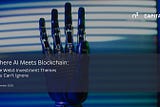Where AI Meets Blockchain: The Web3 Investment Themes You Can’t Ignore

A silent transformation is reshaping the financial and technological order, not with hype but with hard infrastructure. At the heart of this shift is a new global mandate: systems must not only be intelligent, they must be verifiable.
The Autonomous Economy is emerging as the foundational layer of the next decade’s economic architecture. It’s not just about AI accelerating output or blockchain cutting middlemen. It’s about building a future where autonomous systems can operate securely, transparently, and with regulatory-grade trust at scale.
This is not a theory. It’s a strategic allocation framework.
AI is Exploding. But Without Trust, It Stalls.
AI is on a tear with projections to grow from $279 billion in 2024 to over $3.4 trillion by 2033 at a CAGR of 31.5%. But it faces a wall: opacity.
Most enterprise AI today is a black box. It works, until it doesn’t. And in regulated environments like finance, healthcare, or critical infrastructure, “trust us” isn’t good enough. Auditability isn’t a bonus; it’s the buy-in.
This is where distributed ledger technology (DLT) steps in. Not as an add-on, but as a structural necessity. Blockchain enables the cryptographic assurance, data provenance, and policy-bound execution required to make AI safe, lawful, and scalable.
Four Strategic Pillars for Capturing the AI-DLT Premium
Over the next five years, we believe the biggest investment opportunities lie in the infrastructure stack underpinning the Autonomous Economy. These are not speculative plays but rather they are where capital meets compliance, where autonomy meets accountability.
1. Decentralized AI Infrastructure: Compute as a Capital Asset
AI’s hunger for compute is unsustainable under the centralized cloud monopoly. Decentralized GPU networks offer not just scalability, but verifiable execution at lower cost. The market for distributed AI computing is expected to grow substantially over the coming years as the risks of centralized systems become more apparent and the realization that those risks can be reduced via decentralization and implemented at a lower cost is understood.
Platforms are now tokenizing this compute demand through AI Training Contracts thus turning raw computation into predictable, utility-backed yield. These contracts are already being designed for institutional risk profiles, bringing stability to what was once the most volatile corner of digital assets.
2. Cryptographic Verifiability: Auditability is the New Alpha
Regulators aren’t asking if your AI works. They’re asking: Can you prove it?
Zero-Knowledge Machine Learning (ZKML) offers cryptographic proof that an AI decision was made correctly without exposing sensitive data or proprietary models. This isn’t explainability; it’s mathematical assurance.
Enterprises deploying autonomous agents in finance or health tech must meet new standards for auditability. The EU AI Act is just the beginning. The protocols enabling verifiable autonomy will define the next cohort of regulated, insurable AI deployments.
3. AI-Augmented Capital Markets: Tokenization with a Brain
Tokenized real-world assets (RWAs) are projected to reach upwards of $19 trillion by 2033, up from just $600 billion in 2025. But tokenization alone isn’t enough. The complexity of valuation, compliance, and jurisdictional risk requires continuous AI-driven orchestration.
AI is now embedded into issuance platforms, automating everything from project vetting to legal documentation and compliance. The result? Instant settlement, real-time valuation, and dramatically reduced operational friction.
This turns illiquid, expensive-to-manage assets into on-chain, composable, data-rich financial instruments with a risk engine built in.
4. Autonomous Networks and Agentic Systems: Infrastructure for the Autonomous Economy
As AI agents begin to manage portfolios, operate smart grids, and run supply chains, they’ll require identity, governance, and verifiability.
Protocols enabling Self-Sovereign Identity (SSI) and Verifiable Credentials (VCs) will allow agents to operate with the same legal and compliance clarity as a licensed financial institution. Meanwhile, Decentralized Physical Infrastructure Networks (DePIN) will link these agents to real-world assets, closing the loop between digital automation and physical outcomes.
In this world, autonomy is cheap. Trust is scarce. The platforms that prove correctness, compliance, and ethical operation will capture the majority of value.
Why Now: Diverging Capital Flows and Macro Alignment
The capital markets are already signaling this convergence. In Q1 2025, AI captured nearly $60 billion in VC investment. At the same time, Web3 capital is rotating out of speculative assets and into foundational infrastructure such as RWA tokenization, ZK proofs, and compute networks.
This is a flight to quality but also to compliance. The winners will be those who can integrate institutional trust with scalable AI efficiency.
Strategic Capital Allocation: What to Look For
As stewards of long-term capital, institutional and family office investors should be targeting infrastructure, not application layer fads. Here’s what matters:
- Verifiability first: If it can’t prove it works, it won’t scale. ZKML and verifiable autonomy are table stakes.
- AI + compliance: AI isn’t enough. The platforms embedding legal, jurisdictional, and governance logic will win.
- Defensible data pipelines: The real AI moat is data. Platforms that use SSI and digital provenance to feed ethical, high-quality data into AI loops will build unassailable feedback engines.
The Transition to the Autonomous Economy is Not Optional
The next decade will not be won by those who build the smartest AI. It will be won by those who build the most accountable, auditable, and autonomous systems across finance, infrastructure, and digital governance.
We’re entering a new phase where trust is not a reputational asset but an infrastructural requirement. The Autonomous Economy is the only path to scaling AI into the institutions that shape the real economy.
If you’re allocating capital to the future, this is the stack to watch.
Listen To The Article

Black Friday 30%
Offer









